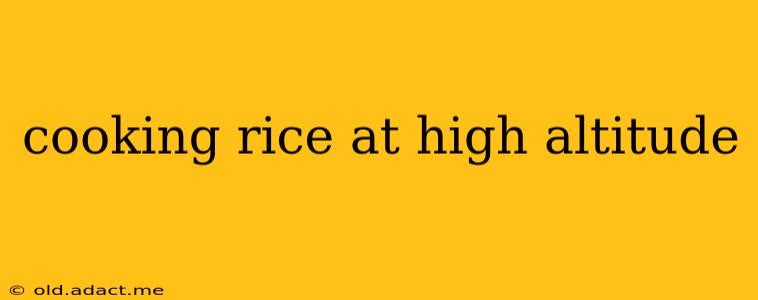Cooking rice at high altitude presents unique challenges. The lower atmospheric pressure at higher elevations causes water to boil at a lower temperature, meaning rice cooked using standard sea-level methods often comes out undercooked or mushy. This guide will address these challenges and provide you with techniques for perfectly cooked rice, no matter how high you are.
Why is Cooking Rice Different at High Altitude?
The reduced atmospheric pressure at high altitude is the primary culprit. Water boils at a lower temperature than at sea level, typically around 200°F (93°C) or lower, depending on the altitude. This lower boiling point means that the rice doesn't reach the optimal temperature needed for proper starch gelatinization, resulting in undercooked grains. This isn't just about the boiling point; the reduced pressure also affects the rate of evaporation, which can lead to uneven cooking.
How Much More Water Do I Need?
This is a common question, and the answer isn't a simple number. You'll need to experiment to find the perfect ratio for your specific altitude and type of rice. However, a good starting point is to increase the water by 10-20%, or even more, depending on your altitude. Begin by adding the extra water and monitoring your rice closely. You may need to adjust the water-to-rice ratio after a few tries to achieve perfect results.
What about the cooking time?
The cooking time might need slight adjustment. Generally, you may need to increase the cooking time by a few minutes. Keep a close eye on the rice to ensure it's cooked through. Using a timer and checking for doneness visually are crucial.
What Type of Rice Should I Use?
While any type of rice can be cooked at high altitude, some are easier to manage than others. Long-grain rice generally performs better at high altitudes than short-grain or medium-grain rice because it's less likely to become mushy.
Tips for Perfect High-Altitude Rice
- Use a lid: A tight-fitting lid helps trap steam and heat, which are crucial for even cooking.
- Don't lift the lid: Resist the urge to peek! Lifting the lid during cooking releases steam and can lead to uneven results.
- Check for doneness: Once the water is absorbed, let the rice sit, covered, for a few minutes to allow the steam to finish cooking the grains. This is called "resting".
- Experiment with different ratios: Find the perfect water-to-rice ratio for your altitude and rice type through trial and error. Keep notes!
- Consider a pressure cooker: Pressure cookers maintain higher pressure and temperature, making them ideal for cooking rice at high altitude. The higher pressure counteracts the reduced atmospheric pressure.
Does the type of pot matter?
While not crucial, using a pot with a heavy bottom can help distribute heat evenly, improving cooking consistency.
Should I use a different cooking method?
While the absorption method (adding water and cooking until absorbed) is standard, you can also explore other methods like using a rice cooker specifically designed for high altitudes (though not all rice cookers compensate for this).
Troubleshooting High-Altitude Rice
- Rice is still hard: You likely need to increase the cooking time or the water-to-rice ratio.
- Rice is mushy: You might have used too much water or cooked it for too long. Try decreasing the water or cooking time next time.
By following these tips and experimenting with the water-to-rice ratio and cooking time, you can consistently enjoy perfectly cooked rice, even at the highest elevations. Remember, practice makes perfect!
